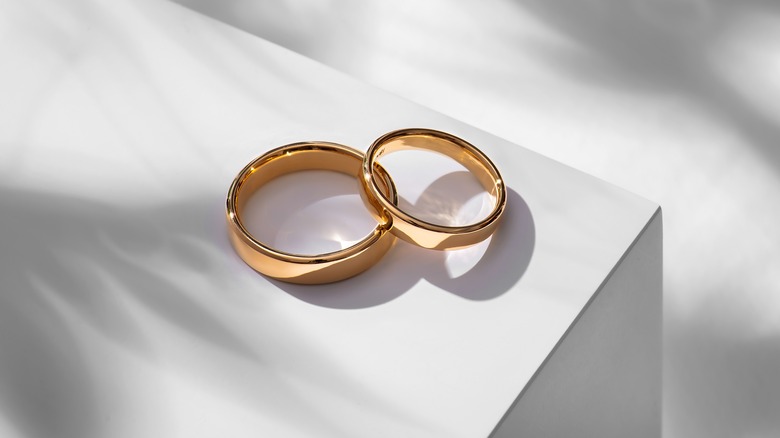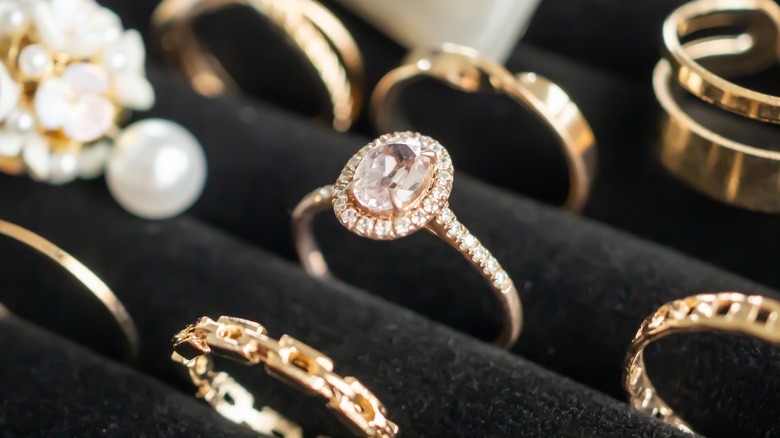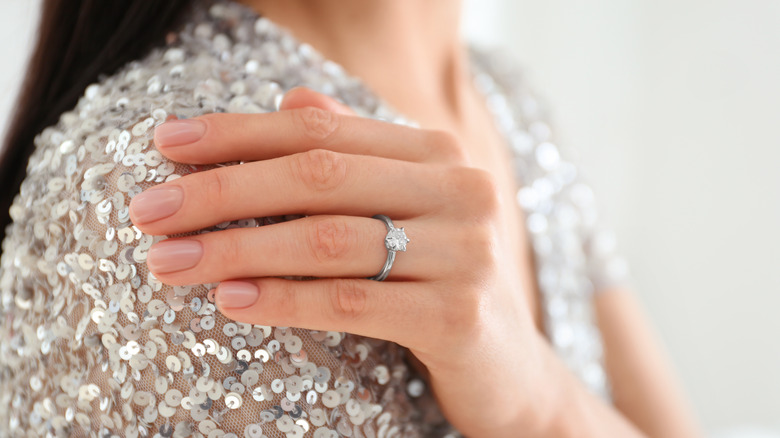How To Choose The Best Metal For Your Engagement Ring
If you are in the planning process for your dream engagement ring, it might be one of the most exciting parts of your wedding journey. If you and your partner are part of the 63% of couples who choose engagement rings together, there are many factors to consider for your pick (via Diamond Designs). Essentially, your engagement ring is a lifelong commitment, so you want to make sure it is meaningful while fitting your aesthetic and lifestyle.
When you think of an engagement ring, you may be visualizing a wedding band with a stone at the center, which is traditionally a diamond ring. The stone is perhaps one of the most captivating aspects of your ring, but the metal band that accompanies it carries a great impact on its appearance and longevity as well. Picking your metal is just as important as the stone and the style you choose. Knowing how to choose the right metal is important so that you can have the best possible outcome for you and your personal preferences. The most popular options to choose from are often gold, platinum, palladium, and silver, per the International Gem Society, but which is the best for you?
Gold is softer and colorful
Gold is a classic option for your engagement ring, and it can be found in more variations like yellow gold, rose gold, or white gold. This allows for the surface color to be more customized while still maintaining a base of gold metal. Because gold is a softer metal, think carefully about how your lifestyle may impact the quality of the metal while you wear your engagement ring.
"Twenty four-karat (pure gold) is so soft that it can easily be scratched or bent, and jewels can easily fall out," the owner of Zachary's Jewelry, Zachary Elliot, tells Brides. "In order to make a ring that is stronger, anything under 24K is always an alloy with other metals, such as copper, silver, or platinum. Of the four most common gold purity levels, 10K is the most durable, though it also has the lowest gold content." According to Jewelry Wise, you can find 22K gold, but you usually find 18K, which is about 75% gold; 14K, which is 58% gold; and 10K which is 42% gold.
The amount of gold content can also be a determining factor for the overall color. For example, the higher the content, the more saturated it looks. Twenty-two-karat gold is a richer, yellow hue, while 14K gold is more of a pale yellow, per Jewelry Wise. If you love warmer-toned jewelry, yellow gold may be the way to go to better fit your aesthetic. Additionally, it tends to be more complimentary to warmer skin tones.
Platinum, silver, and palladium whites
If color isn't much of your aesthetic, consider a white metal instead. One of the most durable and luxurious ring metals available is platinum. It offers a rarity, purity, and durability that comes at a high-end price point. "Platinum is the most expensive metal for jewelry," gemologist and sales manager at James Allen Lorraine Brantner tells The Knot. "While gold market prices may seem higher at times, platinum must only be alloyed with other members of the platinum metal group. It's also harder to work with and requires more finishing steps than gold." Because of its strong durability, this is a great option for anyone with an active lifestyle. On top of being a hypoallergenic metal, it also doesn't fade much over time, so it's a low-maintenance commitment.
Consider a palladium ring if you want a platinum dupe without the platinum price. Like platinum, palladium is a harder, scratch-resistant metal. However, the metal does experience changes over time but maintains its white color for a long time. Many couples opt for palladium as the budget-friendly alternative to platinum, per The Knot.
One of the most affordable metals on the market is silver, which, like gold, is too soft on its own. Because of this, silver is usually mixed with copper and other metals to create sterling silver, making it harder and more durable than pure silver. However, it may require more effort on the maintenance end of things. For example, because it is a soft metal, it can get easily scratched. Silver is also prone to tarnishing, so special storage as well as regular polishing and cleaning can be expected (via Brides). So, which one will you choose?


